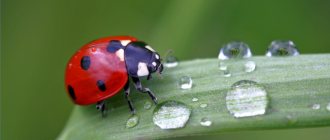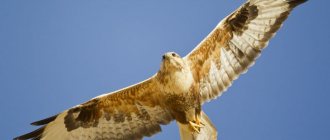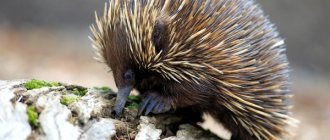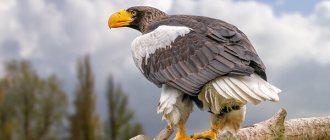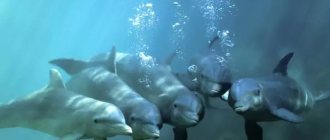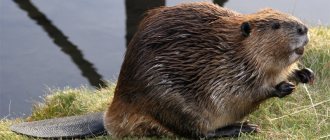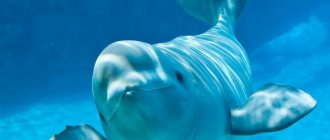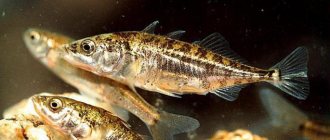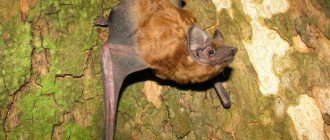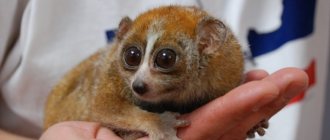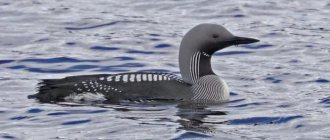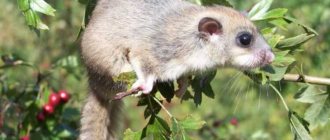- Wild animals
- >>
- Other animals
The horseshoe crab is considered a living fossil. Horseshoe crabs resemble crustaceans, but belong to a separate subphylum of chelicerates, and are closely related to arachnids (such as spiders and scorpions). They do not have hemoglobin in their blood, instead they use hemocyanin to carry oxygen, and due to the copper present in hemocyanin, their blood is blue in color.
Origin of the species and description
Photo: Horseshoe crab
Horseshoe crabs have been around for over 300 million years, making them even older than dinosaurs. They look like prehistoric crabs, but are actually more closely related to scorpions and spiders. The horseshoe crab has a hard exoskeleton and 10 legs, which it uses to walk along the seabed.
Video: Horseshoe crab
Horseshoe crabs have blue blood. Oxygen is carried in their blood by a molecule containing hemocyanin, which contains copper and causes the blood to turn blue when exposed to air. Most red-blooded animals carry oxygen in iron-rich hemoglobin, causing their blood to turn red when exposed to air.
Fun fact: Horseshoe crab blue blood is so valuable that a liter of it can sell for $15,000. This is all because it contains a molecule that is critical to the medical research community. Today, however, new innovations have led to a synthetic replacement that may end the practice of farming horseshoe crabs for their blood.
Vertebrates carry white blood cells in their bloodstreams. Invertebrates such as horseshoe crabs carry amoebocytes. When an amebocyte comes into contact with a pathogen, it releases a chemical that causes local blood to clot, which the researchers believe is a mechanism for releasing dangerous pathogens. Specifically, amoebocytes in a horseshoe crab's blood harden when they come into contact with endotoxins, a pervasive and sometimes deadly bacterial product that triggers the immune system, sometimes leading to fever, organ failure or septic shock.
Reaches the size of a large dish
Over time, Xiphosurida species did evolve; the changes primarily affected their size and led to a loss of segmentation as a whole. The length of a modern adult horseshoe crab is approximately 60 cm. Judging by the fossils found during excavations, its Paleozoic species were only 1-3 cm long before evolution. Due to its large size, the horseshoe crab is called the king crab.
Appearance and features
Photo: What a horseshoe crab looks like
The horseshoe crab's body is divided into three parts. The first section is the prosoma, or head. The horseshoe crab's name comes from the round shape of its head because, like the horseshoes on a horse's hooves, its head is round and U-shaped. It is the largest part of the horseshoe crab's body and contains most of the nervous and biological organs.
Horseshoe crab head includes:
- brain;
- heart;
- mouth;
- nervous system;
- glands - all protected by a large plate.
The head also protects the largest set of eyes. Horseshoe crabs have nine eyes scattered throughout their body and several more light receptors near their tail. The two largest eyes are complex and useful for finding mates. Other eyes and light receptors are useful for detecting movement and changes in moonlight.
The middle part of the body is the abdominal cavity or opisthosoma. It looks like a triangle with spikes on the sides and a mountain range in the center. The spines are movable and help the horseshoe crab. The lower abdomen contains muscles used for movement and gills for breathing. The third section, the horseshoe crab's tail, is called the telson. It is long and pointed, and although it looks scary, it is not dangerous, not poisonous, and does not sting. Horseshoe crabs use the telson to roll over if they end up on their back.
Fun fact: Female horseshoe crabs are about a third larger than males. They can grow up to 46 to 48 centimeters from head to tail, while males are around 36 to 38 centimeters).
Horseshoe crabs breathe through 6 pairs of appendages attached to the lower abdomen called gill books. The first pair protects the other five pairs, which are the respiratory organs and open the pores of the genitals, through which eggs and sperm are expelled from the body.
Development
Embryonic development lasts about six weeks and is accompanied by metamorphosis. However, the larva emerging from the egg has the full number of segments, although the posterior segments of the abdomen are somewhat underdeveloped, since they still lack limbs. This larva is known as the trilobite stage due to its external resemblance to trilobites. The abdomen of the larva ends in a small shield instead of a tail spine. The trilobite larva soon emerges from the sand and is able to swim using the limbs of the opisthosoma. When swimming, it turns over with its ventral side up. The intestines and missing pairs of limbs develop after the first larval molt.
Where does the horseshoe crab live?
Photo: Horseshoe crab in Russia
Today, 4 species of horseshoe crabs have been discovered in the world. The Atlantic horseshoe crab is the only species found in the Atlantic Ocean. The other three are found in Southeast Asia, where the eggs of some species are used as food. In addition to this species, found off the east coast of the United States from Maine south to the Gulf of Mexico to the Yucatan Peninsula.
There are other types:
- Tachypleus tridentum, common in Malaysia, Indonesia and the east coast of China;
- Tachypleus giganteus, living in the Bay of Bengal, from Indonesia and Australia;
- Carsinoscorpius rotundicauda, distributed in Thailand and from Vietnam to Indonesia.
The species of horseshoe crab found in the United States (Atlantic horseshoe crab) is found in the Atlantic Ocean along the coast of North America. Horseshoe crabs can also be seen along the eastern Gulf Coast of the United States and Mexico. There are three other species of horseshoe crabs in the world, which are located in the Indian Ocean and the Pacific Ocean along the coast of Asia.
Horseshoe crabs use different habitats depending on their stage of development. Eggs are laid on coastal beaches in late spring and summer. After hatching, young horseshoe crabs can be found at sea on the sandy ocean floor of tidal flats. Adult horseshoe crabs feed deeper in the ocean until they return to the beach to spawn. Many shorebirds, migratory birds, turtles and fish use horseshoe crab eggs as an important part of their diet. They are a keystone species in the Delaware Bay ecosystem.
Now you know where the horseshoe crab is found. Let's see what he eats.
What does a horseshoe crab eat?
Photo: Horseshoe crab on land
Horseshoe crabs are not picky eaters and will eat almost anything. They feed on small mollusks, crustaceans and worms, but they can also eat other animals and even algae. Thus, the horseshoe crab feeds on worms, small shellfish, dead fish and other organic matter.
Horseshoe crabs do not have jaws or teeth, but they do have mouths. The mouth is located in the center, surrounded by 10 pairs of paws. They feed through a mouth located at the base of their legs, which are covered with thick setae (gnathobases) that point inwards, used to grind food as the animal walks. The food is then pressed into the mouth by the chelicera, which then passes into the esophagus, where it is further crushed and passed into the stomach and intestines. Waste is eliminated through the anus, located on the ventral side in front of the telson (tail).
Gnathobases are sharp, spiny areas located in the middle sections of the foot cups or walking feet. Tiny hairs on the gnathobases allow horseshoe crabs to smell food. The spines, facing inward, tear and crush food, passing it through the paws while walking. They must be in motion to chew their food.
The chelicerae are a pair of anterior appendages that are found in front of the paws. Horseshoe crabs walk along the sandy bottom of shallow water in search of food with their chelicerae. Cilaria are a pair of small, underdeveloped hind legs located behind the animal's paws. The chelicerae and chilaria pass crushed food particles into the horseshoe crab's mouth.
Diet, nutrition
Horseshoe crabs are omnivores, they are carnivores, but they do not refuse algae . The prey of the horseshoe crab can be small fish, snails, and mollusks that have not noticed the danger. They eat arthropods and annelids. Often several individuals can be seen near dead large marine animals. Tearing the flesh with their claws, horseshoe crabs carefully crush the pieces and put them in their mouths with the pair of legs that are located right next to it.
Careful grinding is required to help digest food faster; the arthropod's digestive system is quite complex. And in home aquariums, say lovers of these beauties, armored fossil relics do not refuse pieces of meat and even sausage. You only need to ensure that the water is clean and oxygenated so as not to kill the horseshoe crabs.
Return to content
Features of character and lifestyle
Photo: Horseshoe crab
Horseshoe crabs are known to congregate in large aggregations or groups on beaches, especially in mid-Atlantic states such as Delaware, New Jersey and Maryland during the spring and summer, where their populations are largest. Horseshoe crabs can nest year-round in Florida, with peak spawning times occurring in the spring and fall.
Horseshoe crabs are typically nocturnal animals, emerging from the shadows in the dark to hunt for food. As carnivores, they eat only meat, including sea worms, small mollusks and crustaceans.
Fun fact: Some people consider horseshoe crabs to be dangerous animals because they have sharp tails, but they are completely harmless. In reality, horseshoe crabs are just clumsy, and they use their tail to roll over if they get knocked over by a wave. But they have spines along the edge of their shell, so if you need to handle them, be careful and pick them up from the sides of the shell, not by the tail.
Horseshoe crabs are usually knocked over by strong waves during spawning and may not be able to pull themselves back into place. This often results in the death of the animal (you can help them by gently lifting them from both sides of the shell and releasing them back into the water).
Beach watchers sometimes mistake molting horseshoe crabs for dead crabs. Like all arthropods (including crustaceans and insects), horseshoe crabs have a hard exoskeleton (shell) on the outside of their body. To grow, an animal must shed its old exoskeleton and form a new, larger one. Unlike true crabs, which emerge from their old exoskeletons, horseshoe crabs move forward, leaving the moult behind them.
They are not crabs
They are marine arthropods more closely related to spiders, mites and scorpions than to true crabs.
Like other arthropods, they have a hard shell, a segmented body, and articulated legs. Horseshoe crabs are in their own class - Merostomata - which means "legs attached to the mouth." We also recommend reading:
The largest dog breeds What is domestication in animal husbandry Why you should get a cat: reasons voiced by scientists Euthanasia of animals
Social structure and reproduction
Photo: Horseshoe crab in water
In late spring and early summer, adult horseshoe crabs travel from deep ocean waters to beaches along the Eastern and Gulf Coasts to breed. Males arrive first and wait for females. When females come ashore, they release natural chemicals called pheromones, which attract males and send a signal that it is time to mate.
Horseshoe crabs prefer to breed at night during high tides and new full moons. Males cling to females and head together towards the shoreline. On the beach, females dig small nests and lay eggs, then males fertilize the eggs. The process can be repeated several times with tens of thousands of eggs.
Horseshoe crab eggs are a food source for numerous birds, reptiles and fish. Most horseshoe crabs never reach the larval stage before being eaten. If the egg survives, the larva will hatch from the egg in about two weeks or more. The larva looks like a tiny version of the adult horseshoe crab, but without a tail. The larvae enter ocean waters and settle on the sandy bottom of tidal flats for a year or more. As they develop, they will move into deeper waters and begin to eat more adult food.
Over the next 10 years, young horseshoe crabs will moult and grow. The molting process requires the release of small exoskeletons in exchange for larger shells. Horseshoe crabs go through 16 or 17 molts during their development. At about 10 years of age, they reach maturity and are ready to begin breeding and migrate to coastal beaches in the spring.
In youth they change their shell up to 17 times
Horseshoe crabs move along the bottom by swimming or walking. Since their shell does not grow with them, they have to shed it several times in order to grow further. This can happen 16 to 17 times before the crabs grow to adult size. After this, adults rarely shed their shells.
Natural enemies of horseshoe crabs
Photo: What a horseshoe crab looks like
Today, only 4 species of horseshoe crabs are extant, of which 3 species can be found in the Southeast Asian region. The horseshoe crab's tough mantle prevents any potential predators from accessing those potbellies. They have few known natural enemies other than humans. Their ability to tolerate extreme temperatures and salinity is thought to contribute to the survival of these species. Slow and steady, they are truly true heroes who have survived many times.
Horseshoe crabs are an important part of the ecology of coastal communities. Their eggs are a major food source for birds migrating north, including the federally endangered Icelandic Sandpiper. These shorebirds have evolved to have their migrations coincide with peak horseshoe crab spawning activity, especially in the Delaware and Chesapeake Bay areas. They use these beaches as a gas station to refuel and continue their journey.
Many species of fish, as well as birds, feed on horseshoe crab eggs in Florida. Adult horseshoe crabs are prey for sea turtles, alligators, Florida horse snails and sharks.
Horseshoe crabs play an important ecological role. Their smooth, wide shells provide an ideal substrate for many other marine organisms. As they move along the ocean floor, horseshoe crabs may carry mussels, barnacles, tube worms, sea lettuce, sponges, and even oysters.
Paleontology
Horseshoe crabs are one of the oldest orders. Their first representatives were discovered in Ordovician deposits (approximate age: 485-443 million years ago). It was the kingdom of algae and bacteria, the fauna was just beginning to form, and there is no data yet on completely terrestrial species. Among the currently existing species, sponges, sea lilies and starfish lived in the seas and oceans. Quite close relatives of horseshoe crabs, trilobites, which existed at this time, became extinct at the end of the Permian period. And the horseshoe crabs themselves are still thriving.
Modern horseshoe crabs of the genus Limulus appeared in the Triassic period (250-200 million years ago). At the same time, most species of dinosaurs, oysters, turtles and bony fish appeared. At the end of the period, a quarter of the species of marine animals died, but swordtails survived this cataclysm, having changed little since then.
